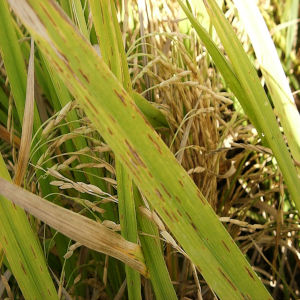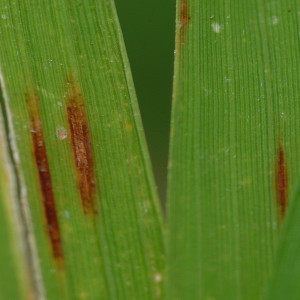- සි
- த

- Address : Bathalagoda, Ibbagamuwa, Sri Lanka
- E- Mail : rrdi@doa.gov.lk
- Telephone : +94 372 258561
- Fax : +94 372 259881
Rice In Sri Lanka - Rice Diseases
Narrow brown leaf spot
Causative agent
Fungus, Sphaerulina oryzina, (Cercospora janseana)
Plant parts and life stages affected
Leaf blades, leaf sheaths, pedicels and glumes
Severity of the disease varies in from year to year and is more severe as rice plants approach maturity.
Severity might also vary based on level of varietal susceptibility. This disease may and cause severe leaf necrosis, some premature ripening, yield reduction and lodging.
Symptoms
Typical lesions on leaves and upper leaf sheath are light to dark brown, linear, and progress parallel to the vein. They are usually 2−10 mm long and 1−1.5 mm wide.
Lesions on the leaves of highly susceptible varieties may enlarge and connect together, forming brown linear necrotic regions.
On glumes, lesions are usually shorter but can be wider than those on the leaves. Brown lesions are also found on pedicels.
The disease also causes discoloration on the leaf sheath, referred to as “net blotch” because of the netlike pattern of brown and light brown to yellow areas.


Disease Management
Within the crop season
Application of urea in recommended dosages or application of urea based on leaf colour chart.
If the crop is infected, following management options should be applied for the next season
Application of organic fertilizer to improve soil
Use of certified seed paddy free from the disease
Addition of burnt paddy husk (250 kg per acre) to the soil during land preparation.
Abstain addition of disease infected straw.
